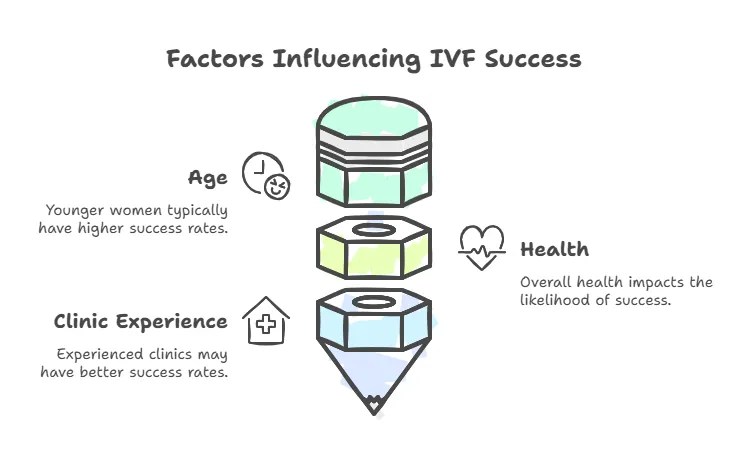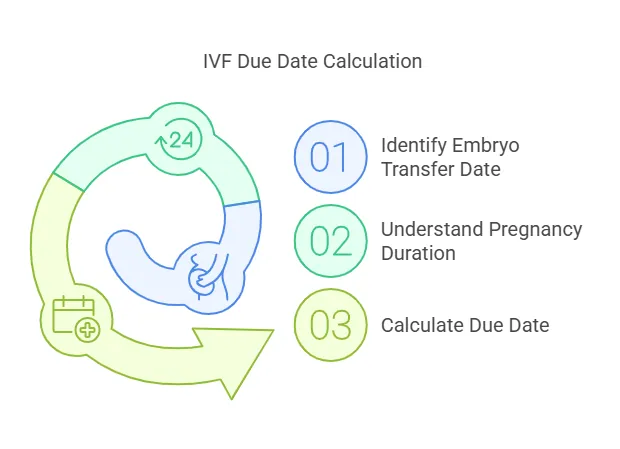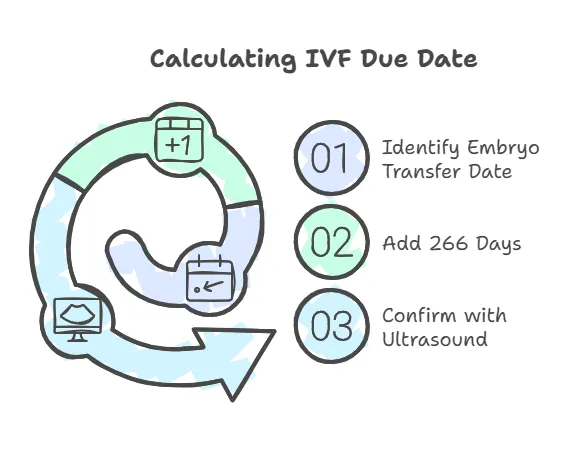IVF Pregnancy Due Date Calculator

In Vitro Fertilization (IVF)
In vitro fertilization (IVF) is a medical treatment that helps people who have trouble having a baby naturally. It combines special medical steps with personal care to give hope to those wanting to start or grow their family.
The process includes stimulating the ovaries to produce several eggs, collecting these eggs, and mixing them with sperm in a lab to help fertilization. The fertilized eggs, now called embryos, are then carefully chosen and placed into the uterus, where they may grow into a healthy pregnancy.
IVF has been used for many years, and improvements in medicine have made it more successful and safer. However, the process can be both emotional and physical, so good planning, support, and guidance from doctors are important.
This guide will explain each step of IVF, from the first doctor’s visit to what happens after the embryo is transferred. Whether you are trying IVF for the first time or going through it again, this information will help you understand the process and make the best choices for your journey.



Step-by-Step Guide to In Vitro Fertilization (IVF)
IVF is a treatment that helps people have a baby when natural pregnancy is difficult. Here is a simple breakdown of the process:
1. Getting Started
Before starting IVF, both partners may need tests to check their health and fertility. These tests can include blood work, semen analysis, and ultrasounds. A doctor will review the results and explain treatment options.
2. Taking Fertility Medications
Medicine is given to help the ovaries produce more eggs. Doctors closely monitor this process with blood tests and ultrasounds to make sure the eggs are developing properly.
3. Trigger Shot
Once the eggs are ready, a special injection is given to help them mature. This is called the “trigger shot” and prepares the eggs for collection.
4. Egg Retrieval
About 36 hours after the trigger shot, a minor procedure is done to collect the eggs. The doctor uses a thin needle to gently remove the eggs from the ovaries. This is done under light anesthesia, so there is no pain.
5. Sperm Collection
On the same day as egg retrieval, the male partner provides a sperm sample. If using donor sperm, it is taken from a sperm bank. The best sperm are selected for fertilization.
6. Fertilization (Combining Egg and Sperm)
The eggs and sperm are mixed in a lab to create embryos. Sometimes, a single sperm is directly injected into an egg to help fertilization (this is called ICSI).
7. Embryo Growth
After fertilization, the embryos are watched closely to make sure they are developing correctly. Doctors may wait 3 to 5 days before choosing the best embryos for transfer.
8. Embryo Transfer
A thin tube is used to place one or more embryos into the uterus. This is a simple and painless procedure. Any extra healthy embryos can be frozen for future use.
9. After the Transfer
After the procedure, normal activities can usually be resumed within a day or two. The doctor may prescribe medications to help support the pregnancy.
10. Pregnancy Test
About 10 to 14 days after the embryo transfer, a blood test is done to check if pregnancy has started. If the test is positive, an ultrasound is scheduled in a few weeks to confirm the pregnancy.

Possible Risks
- Multiple Pregnancy: If more than one embryo is transferred, there is a chance of twins or more.
- Miscarriage: Some pregnancies may not continue after implantation.
- Ectopic Pregnancy: In rare cases, the embryo may grow outside the uterus.
- Ovarian Hyperstimulation Syndrome (OHSS): Some women may react strongly to fertility medications, causing swelling and discomfort.

Success Rates
IVF success depends on factors like age, health, and clinic experience. Younger women usually have higher success rates. Your doctor will discuss what to expect based on your situation.
IVF is a detailed but effective way to help people start a family. Doctors carefully monitor every step to increase the chances of a healthy pregnancy.

How to Calculate the Due Date for an IVF Pregnancy
Calculating the due date for an IVF pregnancy is different from a natural pregnancy because it starts from the embryo transfer date, not the last menstrual period. Here’s a simple way to figure it out:
Step-by-Step Guide
1. Find the Embryo Transfer Date
- This is the exact day the embryo was placed in the uterus. It is the starting point for the due date calculation.
2. Know How Long Pregnancy Lasts
- A full-term pregnancy is about 40 weeks (280 days) from the last menstrual period in a natural pregnancy.
- For IVF, the pregnancy length is counted as 38 weeks (266 days) from the embryo transfer date.
3. Add 266 Days to the Embryo Transfer Date
- Since the embryo transfer date is like the start of pregnancy, adding 266 days gives the estimated due date.

Example Calculation
If the embryo transfer happened on March 1, 2023:
- Start with March 1, 2023
- Add 266 days
- The estimated due date would be November 28, 2023
Things to Keep in Mind
- Ultrasound Check: Early ultrasounds help confirm the due date by measuring the baby’s size.
- Twins or More: If multiple embryos were transferred, the due date stays the same, but the pregnancy may end earlier.
- Early or Late Birth: Some babies come before or after the due date, so regular doctor visits are important.

Quick Summary
To find the IVF due date:
- Take the embryo transfer date.
- Add 266 days (38 weeks) to it.
- Confirm with an ultrasound if needed.
This method gives a good estimate, but every pregnancy is different. Regular check-ups help keep both the baby and the mother healthy.

